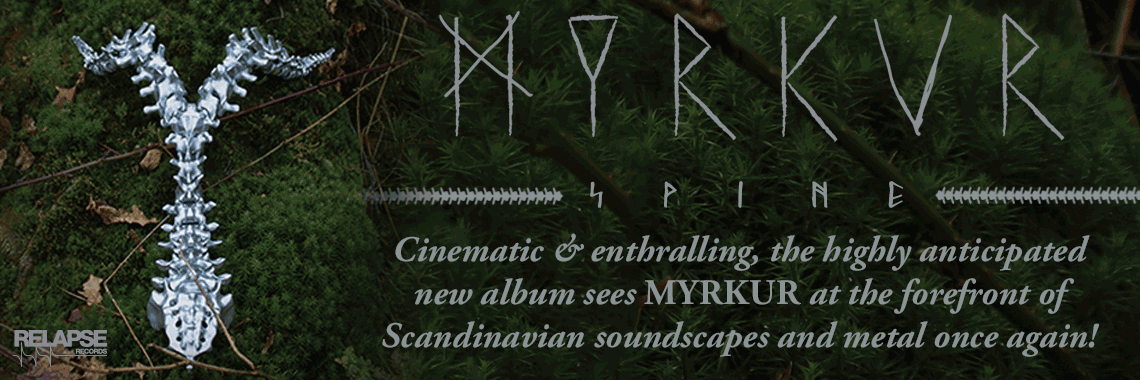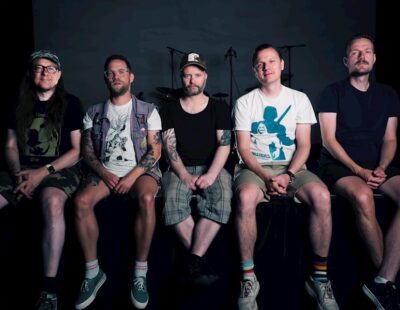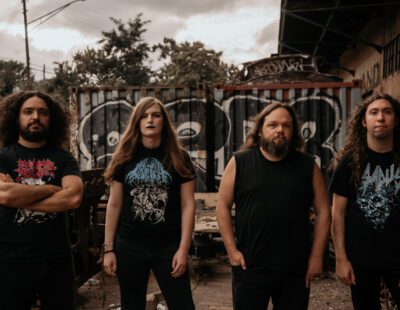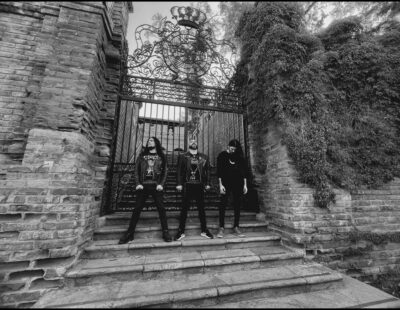Michael Klassen has never met Daniel Jansson. OK, you’re thinking, why should he? But given that Jansson is the singer in his band, it is kind of weird. Well, unconventional certainly. Klassen plays guitar, bass and provides other instrumentation in Culted, working out of Winnipeg, Canada, with Kevin Stevenson (Drums), Matthew Freisson (guitar/bass/other) and Erik Larsen (modular synths/other) to create huge doom tracks to be zipped and shipped via a broadband internet connection to their vocalist in Sweden.
It’s one of the few long-distance relationships that work. When Klassen met Jansson he was looking for the Swede to do some work on his black metal project, Of Human Bondage (named after the 1934 Bette Davis flick). But that all changed, ideas were exchanged, there were shared influences, and what started out as a proposition for some guest work led to one of the most interested doom bands around at the moment. Culted pool together a lot of influences; there is some of that black metal in there but it is shadowed way down in the background, and there is plenty of space to get lost in Culted’s sound. And that sound is expanding all the time. While their 2009 debut, Beyond the Thunder of the Upper Deep was a big-riffed, slo-mo beast, perhaps in the same genus as Indian’s oeuvre, Oblique to All Paths is a bravura exercise in expansion. It’s a bold record. The first track is is 20 minutes long. The physicality of the riff is still in there, but obscured by krautrock, drone and electronic noise and hiss. It’d be hard to ever imagine Culted touring, but, as Klassen testifies, distance is no barrier to creative prosperity.
Oblique to All Paths sounds like you’ve really expanded upon your sound, with everything bigger: was this a conscious decision?
I don’t know if it was deliberate, I mean, I don’t think that we went for a bigger sound, we just kind of did the same things as we did the last time and, as things started progressing, the songs themselves lent themselves to a little bit more space to add more layers. To get the songs to a level where we thought that they were complete they just needed more, and I don’t know if it was the way we wrote the riffs this time but there is definitely more room to add to that. But I don’t think we went in ahead of time with a set agenda to make it bigger. The recording process was very similar to the last one.
How long did it take you to put together? I’d imagine the situation with three of you in Canada and Daniel in Sweden could could pose a challenge.
Well, absolutely. But the convenient thing about our situation is that it is often months between sessions. Other than the guitar tracks, which were done over a two-month period, it was only about six days of actual tracking, but that was done over two weeks, like every second weekend we set aside one or two days and we’d work on guitars, and once those guitars and drums are done. The drums are done in four hours; the setup took longer than the tracking as we had five or six hours setting up the mics in the room and Kevin tracked the drums in four hours. What else do we do with our time? Once those tracks are done we send them to Daniel to really have a go at it, and he spends three or four months before he sends us anything, so you’re really left with a lot of time to sit and ponder what you’ve contributed so far and you wait to see what he comes back with. You just sit with it for a bit and get a feel for where the songs are heading. You start planning things, finding out when we can all get a session together. You listen back to the tapes and the songs begin to present themselves to you; you notice where they need flourishes, nuances, overdubs, more guitars, more or less vocals, edits. You just throw stuff at it––it’s kind of like a painting, throwing paint and seeing what sticks. And we really, in some places, overdid it and then after months of listening to it when mixing it, and a lot of the mixing process was a lot of editing, taking stuff out and finding levels that worked, finding a balance between the different instrumentation.
Is there an element of surprise when you get the tracks back from Daniel? Like you said, there is a lot of time to build up an impression of how the songs will eventually sound.
Upon hearing the finished product? Well we send it to Daniel as soon as the guitars and drums are done, and we don’t add bass until Daniel sends his tracks back––at least this time. I think on the first two records we did guitars, drums and bass here and then sent them to Daniel. This time we just got the guitars and drums tracked and sent them without bass. We got his stuff back and then started adding bass and start trying to find nuances between his vocalisations, the drum patterns, and trying to figure out where we can fit in that bass sound to really accentuate parts. So yeah, every time we do anything we send it all back to Daniel and he will make changes, add parts as he sees fit, maybe cut something out, and we might edit some of his vocals or make suggestions. It’s really just this back and forth, hearing what everybody has contributed and sometimes what you’ve contributed just doesn’t work. That’s when you learn that it is not about the individual, it’s about the collective and what works for each song and what works for the album. When you get to the final product it sounds nothing like [it does] when you are sitting in your basement with that urge to write riffs. I mean, you get that urge to write riffs, and you write riffs and try make a song out of it, and it just becomes this whole other beast.
This is the first time Erik Larsen’s been on board for the writing and recording. What did he add to the record?
I met Erik after the last record. He actually started working at the same place I work, right before Below the Thunders . . . came out. He works at the same school I work at. We’d seen each other at shows and said, ‘Hey, we know each other’, so we started talking music at breaks, music philosophy. He is into metal and strange sounds, but we really found a common ground in krautrock, industrial, no-wave and all these great New York sounds. He was dabbling in modular synths and he had a cool Moog, and had some really cool stuff, and we’d got together in our jam space, just him and I, and made some really cool sounds together. It planted the seed for a year or two later, after we had tracked the initial guitars and drums. The record was screaming for this other sound, and these modular synths just seemed to be to be perfect, the missing link that I felt these songs were gonna need. He doesn’t do all the electronics on the record; both Matt and I [do some], we have a Moog at our place, an organ and a couple of other keyboards, and Erik isn’t just playing modular synths either. We had these kettle drums at our school that the music program had rented, and rental time was over, we thought it was just too good an opportunity so we brought a bunch of mics in and he played them, mic’d them, recorded them and we used a couple of those sounds on the record. He found these cool nuances of metallic reverberation and put them through a couple of different outboard gear and got these really cool alien sounds. When he found something, he knew exactly where to put it on the record.
You are a metal band, but you do repurpose krautrock and no-wave and so on. Was that a big thing for you to have those influences coming to the fore?
Yeah, absolutely. Yeah! As excited as I get for a great metallic release, or any loud release, drone, doom or whatever, I get just as excited when I discover Moondawn by Klaus Schaultze. I’m still discovering Einstürzende Neubauten’s discography, Swans; these releases expand beyond the parameters of rock. No matter how old they are, how long ago they were recorded, they still scream of forward thinking, of experimental forethought. It’s a truly psychedelic experience, at least that’s how I interpret the effect it has on my brain and how I interpret sound. Yeah, that mixed with any great metallic release, that combination to me, any time I can feel that inspired by sound is magic.
I read an interview where you said your path into metal was pretty standard, old Metallica et al planting the seed, but what was the big musical epiphany for you that led to an appreciation that metal could be something different?
It was Neurosis, Through Silver in Blood. I am from a small town just outside of Winnipeg, which is the large capital city of Manitoba in central Canada. We were pretty isolated. Like you said, I grew up with thrash and death metal, Black Sabbath. The classics. I moved to the city and was trying to find bands to jam with, y’know the standard thrash-type thing, and I had just joined a grind band, playing bass for them, and they were great. Specifically their guitarist Clint. The whole band were; they just had this whole other outlook on music. We were a grind band but they had just had so much exposure to other sounds that I hadn’t even heard of. I was over at Clint’s house and he had the LPs of Eyehategod’s Dopesick, and Through Silver in Blood. I mean I had heard Black Sabbath, but this was loud like death metal but had this whole other component, this other worldly riffing style, it was slowed-the-fuck right down and there was this whole electronic element. It reached another dimension; it was the first time I realised there was this whole unexplored realm of sound that I was unfamiliar with, and I couldn’t believe that this band had an entire discography that preceded this album. That was how absolutely basic my knowledge of experimental or noise music, how small my knowledge was of all these great sounds that are out there.
It’s funny you mention Neurosis because for me they were one of the first bands that required a total immersion and an investment on behalf the listener, and, similarly, Oblique to All Paths requires that investment, as it reveals itself over time. Did you wonder how people would react to it?
Haha! Y’know that didn’t come into play until the final mixes, and realising––I mean sometimes for us there is so much time between albums and we are not a touring band, so we don’t have that exposure to audiences and feedback, and get that fast song out there first so you have this impact. That didn’t come into play until we were doing the final mixes and I realised that our opening track is close to 20 minutes long, but never in the whole time that we were mixing it did I think that this was not the song to open the record. “Brooding Hex” was always always the first song, “Illuminati” was always second, and that was imprinted on my brain since after we done the basic tracks.
Given your working practices, sharing tracks over a broadband internet connection having never met your singer, you’re very much a band of our time. But maybe also an antidote to our time, as you’re making people invest in music when, arguably, people’s attention spans are compromised by modern life.
I don’t think I have ever thought about how other people perceive it, but I enjoy listening to our music to that to me. I’ve had the most profound experiences with bands that do that, and when we were putting this record together we get into this headspace of––I don’t even know how to explain this––where things slow down even further and you get within the riff, and you kinda fall in-between these layers of sound, without the use of drugs or alcohol you are able to really reach a psychedelic or an ecstatic state, this idea of the peak experience within sound. Yeah, it’s hard to describe. You don’t really notice it when it happens, you are too in it. It’s not until you think back on it. It’s a state of grace.
Culted’s Oblique to All Paths is out now on Relapse, order it here






